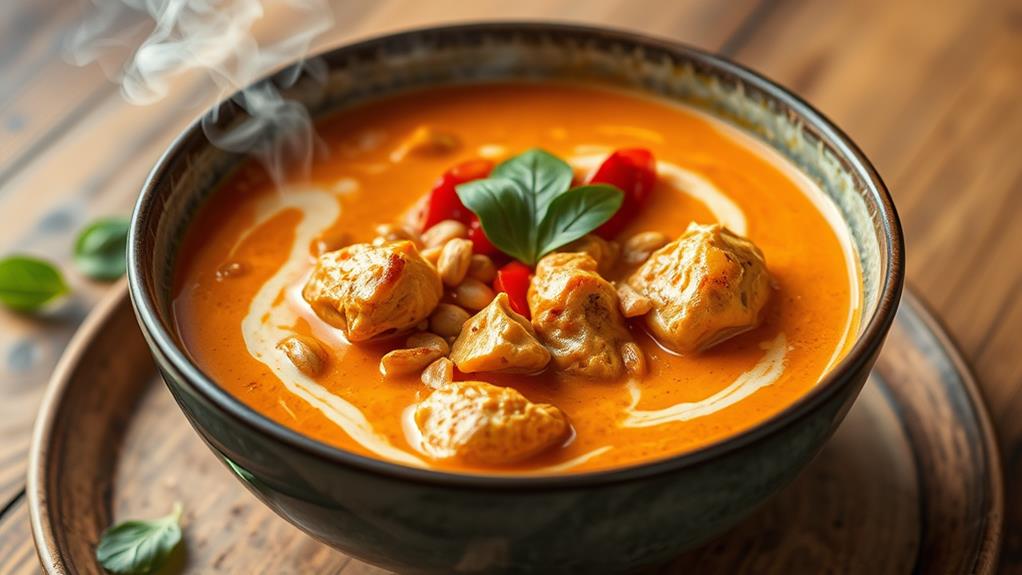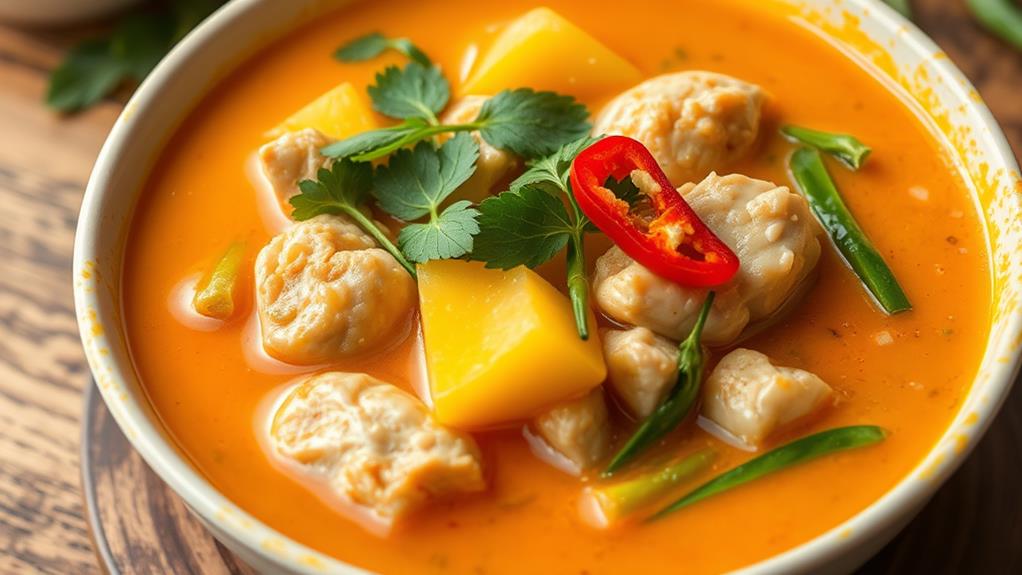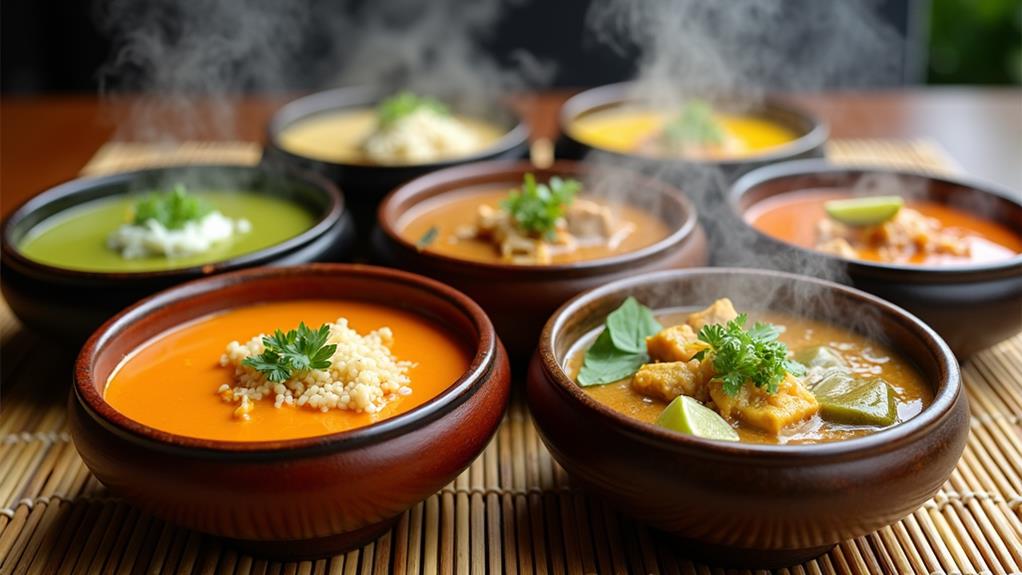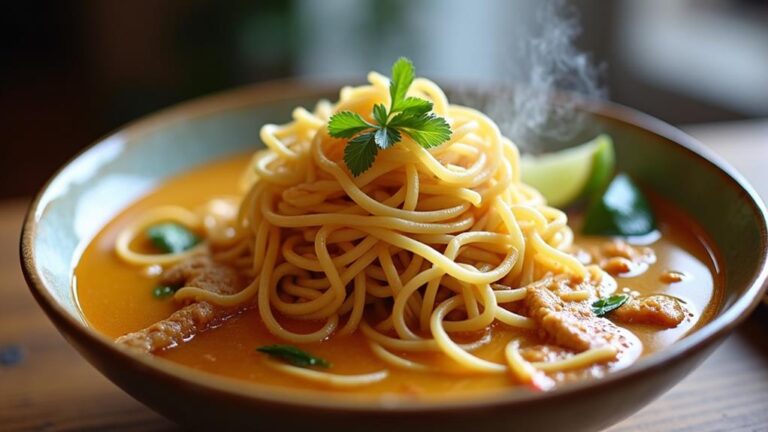When exploring Thai curries, you'll find a vibrant array of flavors to suit every palate. Green curry offers a spicy, aromatic experience, while red curry brings bold, fiery heat. For milder options, try the comforting yellow curry or the rich, nutty massaman. Panang curry delights with its creamy texture and nuanced taste. If you're feeling adventurous, jungle curry packs an intense punch, while sour curry tantalizes with its unique tanginess. Don't overlook the sweet and savory pineapple curry for a tropical twist. Each curry type showcases Thailand's culinary mastery, inviting you to embark on a flavorful journey through the country's diverse spice traditions.
Table of Contents
Key Takeaways
- Green Curry is considered the crown jewel of Thai curries, known for its vibrant color and complex flavor profile.
- Red Curry is the boldest and spiciest option, featuring a fiery paste balanced by creamy coconut milk.
- Yellow Curry offers a milder, approachable choice with turmeric and curry powder, suitable for those new to Thai cuisine.
- Massaman Curry presents a unique blend of Thai and Islamic influences, with a rich, nutty flavor and tender meat.
- Panang Curry delivers a creamy, nuanced experience with a velvety texture and delicate yet flavorful taste.
Green Curry: Spicy and Aromatic
When it comes to Thai cuisine, green curry stands out as the crown jewel of curries. This fiery and aromatic dish is renowned for its vibrant green color and complex flavor profile, making it the most popular and unique among Thai curries.
The secret to green curry's distinctive taste lies in its carefully crafted Thai curry paste. You'll find a harmonious blend of green chilies, lemongrass, fish sauce, garlic, ginger, and shallots at its core. What sets it apart, however, is the addition of fragrant herbs like coriander, makrut lime leaves, and basil. These ingredients not only contribute to the curry's striking green hue but also infuse it with layers of fresh, zesty flavors.
As you savor a spoonful of green curry, you'll experience an explosion of spiciness balanced by aromatic notes. The heat from the green chilies is tempered by the cooling effect of coconut milk, creating a perfect equilibrium.
Whether you're enjoying it with tender chicken, succulent beef, or delicate fish dumplings, green curry promises an unforgettable culinary journey that will transport your taste buds straight to the heart of Thailand.
Red Curry: Bold and Fiery
While green curry tantalizes with its fresh, aromatic profile, red curry takes center stage as the boldest and most fiery of Thai curries. You'll find that red curry paste packs a punch with up to 20 red chilies, creating an intense heat that's not for the faint of heart. This vibrant curry combines garlic, spices, galangal, and shrimp paste, resulting in a complex flavor profile that's both rich and spicy.
When you immerse yourself in a bowl of red curry, you'll experience a harmonious blend of flavors. The coconut milk balances the heat, while the spices dance on your palate. Modern versions may incorporate chili powder and tomato sauce, adding depth and enhancing the curry's signature red hue.
For spice enthusiasts, Thai red curry is a must-try. Dishes like Thai red curry with chicken showcase the robust flavors of this traditional curry. As you savor each spoonful, you'll appreciate the bold taste and fiery kick that sets red curry apart from its milder counterparts. It's a culinary adventure that'll leave your taste buds tingling and craving more.
Yellow Curry: Mild and Comforting
You'll find yellow curry to be a gentler, more approachable Thai curry compared to its bolder counterparts. Its mild, slightly sweet flavor profile is enhanced by a delicate balance of turmeric, curry powder, coriander seeds, and lemongrass.
These key ingredients, often combined with creamy coconut milk, create a comforting dish that's perfect for those new to Thai cuisine or seeking a less fiery option.
Flavor Profile
Yellow curry boasts five distinct flavor elements that create its mild and comforting profile. You'll experience a subtle sweetness balanced with a gentle hint of spice, courtesy of the turmeric, cumin, and coriander seeds. The aromatic blend of these spices forms the foundation of yellow curry's unique taste.
As you savor each spoonful, you'll notice the creamy richness imparted by coconut milk, which envelops the spices and creates a velvety texture. This combination results in a soothing and satisfying dish that appeals to a wide range of palates.
The vibrant golden-yellow hue of the curry comes from the prominent use of turmeric, which not only adds color but also contributes to its distinct flavor. You'll find that yellow curry offers a harmonious fusion of Thai and European culinary influences, making it a versatile and approachable choice for curry lovers.
For those seeking variety, you can explore different iterations like gold curry, elephant curry, and orange curry. Each of these variations provides unique taste experiences and varying levels of spice, allowing you to discover your preferred flavor profile within the yellow curry spectrum.
Common Ingredients
The heart of yellow curry lies in its thoughtfully chosen ingredients, each contributing to its distinctive flavor profile and comforting nature. You'll find that turmeric plays a leading role, lending its vibrant golden hue and earthy undertones to the dish. Alongside turmeric, curry powder, coriander seeds, and cumin work in harmony to create a complex and aromatic base.
Lemongrass adds an invigorating citrusy note, while garlic provides a pungent kick that balances the overall flavor. When combined with rich, creamy coconut milk, these ingredients transform into a luscious, velvety sauce that's both soothing and indulgent.
As you savor a spoonful of yellow curry, you'll experience:
- The warmth of turmeric enveloping your senses
- A gentle heat that awakens your taste buds
- The comforting embrace of coconut milk
- A symphony of aromatic spices dancing on your palate
- A subtle sweetness that lingers, leaving you craving more
Whether you're enjoying a fish stew or a vegetable-laden version, yellow curry's common ingredients work together to create a dish that's both familiar and exotic. It's a tribute to the versatility of Thai cuisine, offering a milder alternative to its spicier counterparts while still delivering a depth of flavor that's truly unforgettable.
Massaman Curry: Rich and Nutty
A culinary gem among Thai curries, Massaman curry stands out with its rich, nutty profile and unique blend of spices. You'll find this curry's origins in central Thailand, where Islamic influences have shaped its distinctive flavor. When you taste Massaman curry, you'll experience a harmonious mix of cardamom, cloves, star anise, bay leaves, and white pepper, alongside traditional Thai ingredients like lemongrass, galangal, and coconut milk.
The Massaman curry paste forms the foundation of this dish, creating a rich and creamy texture that sets it apart from other Thai curries. You'll often find potatoes and peanuts nestled within, adding depth and nuttiness to each spoonful. If you're new to Thai cuisine or prefer milder flavors, Massaman curry is an excellent choice. Its relatively mild flavor profile makes it accessible to a wide range of palates.
For a truly indulgent experience, try Slow-Roasted Duck Massaman, which showcases the curry's ability to balance sweet, savory, and aromatic notes. As you savor each bite, you'll appreciate the complex layers of flavor that make Massaman curry a beloved Thai classic.
Panang Curry: Creamy and Flavorful

Among Thai curries, Panang stands out for its creamy texture and nuanced flavor profile. Originally from Laos, this curry has become a beloved staple in Thai cuisine. The secret to its rich taste lies in the unique blend of spices used in the paste, including coriander root and seeds, galangal, cumin, and garlic. These aromatic ingredients create a harmonious balance of salty, sweet, and nutty flavors that'll tantalize your taste buds.
When you indulge in Panang curry, you'll experience:
- A velvety smooth texture that coats your palate
- A delightful interplay of subtle flavors that dance on your tongue
- The comforting warmth of coconut milk enveloping each bite
- A gentle nuttiness from roasted peanuts that adds depth
- An irresistible aroma that captivates your senses
Chefs often add their personal touch to Panang curry, enhancing its already complex flavor profile. The addition of roasted peanuts, for instance, elevates the dish's nuttiness and adds a satisfying crunch.
Whether you're a curry connoisseur or a newcomer to Thai cuisine, Panang curry offers a delicate yet flavorful experience that's sure to leave you craving more.
Jungle Curry: Intensely Spicy
Shifting gears from the creamy indulgence of Panang curry, we encounter the fiery force of Jungle curry. This intensely spicy Thai dish isn't for the faint of heart, offering a full-throttle assault on your taste buds.
Unlike its coconut milk-based counterparts, Jungle curry delivers a pure, unadulterated curry paste experience that's both bold and robust.
You'll find that Jungle curry lives up to its reputation as one of the hottest Thai curries. Its intense flavor profile is characterized by a vibrant mix of spices and herbs, creating a complex taste that's simultaneously invigorating and challenging.
As you savor each spoonful, you'll notice the absence of coconut milk allows the curry paste's fiery nature to shine through unimpeded.
For those seeking an authentic Thai culinary adventure, traditional recipes like Thai Jungle Curry showcase the dish's true essence. It's a spicy and vibrant experience that pushes the boundaries of your palate.
If you're a fan of bold flavors and crave a curry that packs a serious punch, Jungle curry is your ticket to an exhilarating gastronomic journey through Thailand's culinary landscape.
Sour Curry: Tangy and Unique

Tangy and distinctive, sour curry stands out in the Thai curry lineup with its unique flavor profile. Unlike its creamy counterparts, this invigorating alternative doesn't rely on coconut milk for its base. Instead, it derives its characteristic sourness from tamarind or sour fruit, creating a zesty and revitalizing taste experience.
The beauty of sour curry lies in its simplicity, typically featuring five key ingredients that work in harmony to deliver its tangy flavor. This unique taste profile offers a delightful contrast to the rich and spicy curries you might be more familiar with. As you savor each spoonful, you'll notice the natural acidity of the tamarind or sour fruit, which forms the backbone of this dish.
- Awaken your taste buds with a burst of tanginess
- Experience a curry that's invigoratingly different
- Discover the perfect balance of sour and savory
Explore the complexity of flavors in its simplicity
– Embrace a lighter, yet equally satisfying curry option
Sour curry showcases the diversity of Thai cuisine, proving that not all curries need to follow the same creamy, coconut-based formula. It's a demonstration of the ingenuity of Thai cooks who've crafted a curry that's both bold and nuanced, offering a unique culinary adventure for those willing to explore beyond the traditional.
Pineapple Curry: Sweet and Savory
You'll discover a delightful interplay of flavors in pineapple curry, where the sweetness of tropical fruit mingles with the savory depth of Thai spices.
This unique curry challenges your palate, balancing the tanginess of pineapple with the richness of coconut milk and the heat of curry paste.
As you explore the cooking techniques, you'll find that the key lies in allowing the pineapple to simmer just long enough to infuse the curry with its essence without losing its juicy texture.
Flavor Profile Analysis
Among the diverse array of Thai curries, Pineapple Curry stands out for its intriguing balance of sweet and savory flavors. This unique Thai dish marries the tropical sweetness of pineapple with the rich, savory notes of curry paste, creating a harmonious blend that tantalizes your taste buds. As you savor each spoonful, you'll notice how the tanginess of the pineapple is perfectly offset by the creamy richness of coconut milk, resulting in a curry that's both invigorating and indulgent.
The flavor profile of Pineapple Curry evokes a sense of culinary adventure, transporting you to exotic shores with every bite. Its tropical twist on traditional Thai curry offers:
- A burst of sunshine in your mouth
- An unexpected dance of flavors on your palate
- A revitalizing break from conventional curries
- A taste of paradise in your own home
- A culinary journey to Thailand's beaches
This curry's unique composition makes it a popular choice for those seeking to explore the diverse world of Thai cuisine. The interplay between sweet and savory elements creates a complex yet approachable flavor profile that appeals to both curry enthusiasts and newcomers alike.
Cooking Techniques Explored
Crafting the perfect Pineapple Curry requires a delicate balance of cooking techniques to harmonize its sweet and savory elements. You'll start by creating a flavorful base using Thai red curry paste and coconut milk, which forms the foundation of this versatile dish. As you simmer these ingredients, you'll notice the aromatic spices beginning to infuse the creamy coconut milk.
Next, you'll introduce chunks of juicy pineapple to the mix. The key is to add them at the right moment – too early, and they'll break down completely; too late, and they won't absorb enough flavor. You'll want to achieve a perfect balance where the pineapple retains its texture while soaking up the curry's essence.
If you're adding protein like chicken or shrimp, you'll need to time this carefully as well. Cook it just enough to make sure it's done without becoming tough or rubbery.
As the dish comes together, you'll find yourself adjusting the seasoning, perhaps adding a touch more sweetness or spice to create that unique blend of flavors that makes pineapple curry so irresistible. Remember, the goal is to achieve a harmonious sweet and savory profile that tantalizes your taste buds.
Frequently Asked Questions
What Type of Thai Curry Is the Best?
Variety is the spice of life, and Thai curries prove it. You'll find your favorite by exploring each unique flavor. Green's vibrant, red's fiery, yellow's mild, massaman's aromatic, and panang's rich. They're all delicious in their own way.
What Is the Most Famous Curry in Thailand?
You'll find that green curry reigns supreme as Thailand's most famous curry. It's beloved for its vibrant color and fresh, herbaceous flavors. You can't miss trying this iconic dish, bursting with aromatic spices and creamy coconut milk.
Which Curry Tastes the Best?
You'll be blown away by the explosion of flavors in Thai curries! Taste is subjective, but you might find green curry's creamy spiciness or red curry's intense heat most appealing. Don't forget to try the milder yellow or unique Massaman varieties.
Is Red or Green Thai Curry Better?
You'll find that red and green Thai curries offer distinct experiences. If you're craving heat and depth, red's your go-to. For a milder, herbaceous flavor, green's your best bet. It's all about your personal palate preferences.











